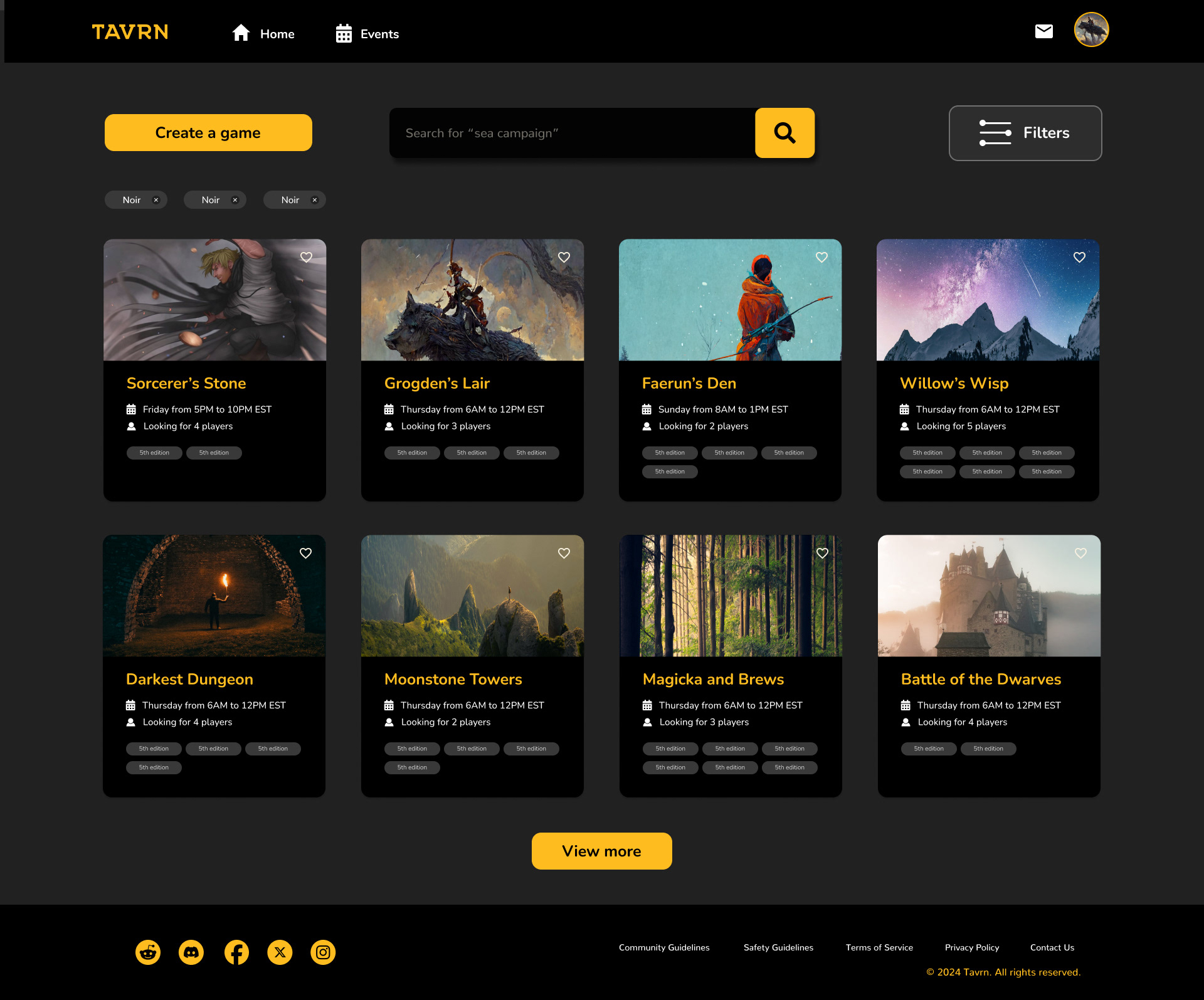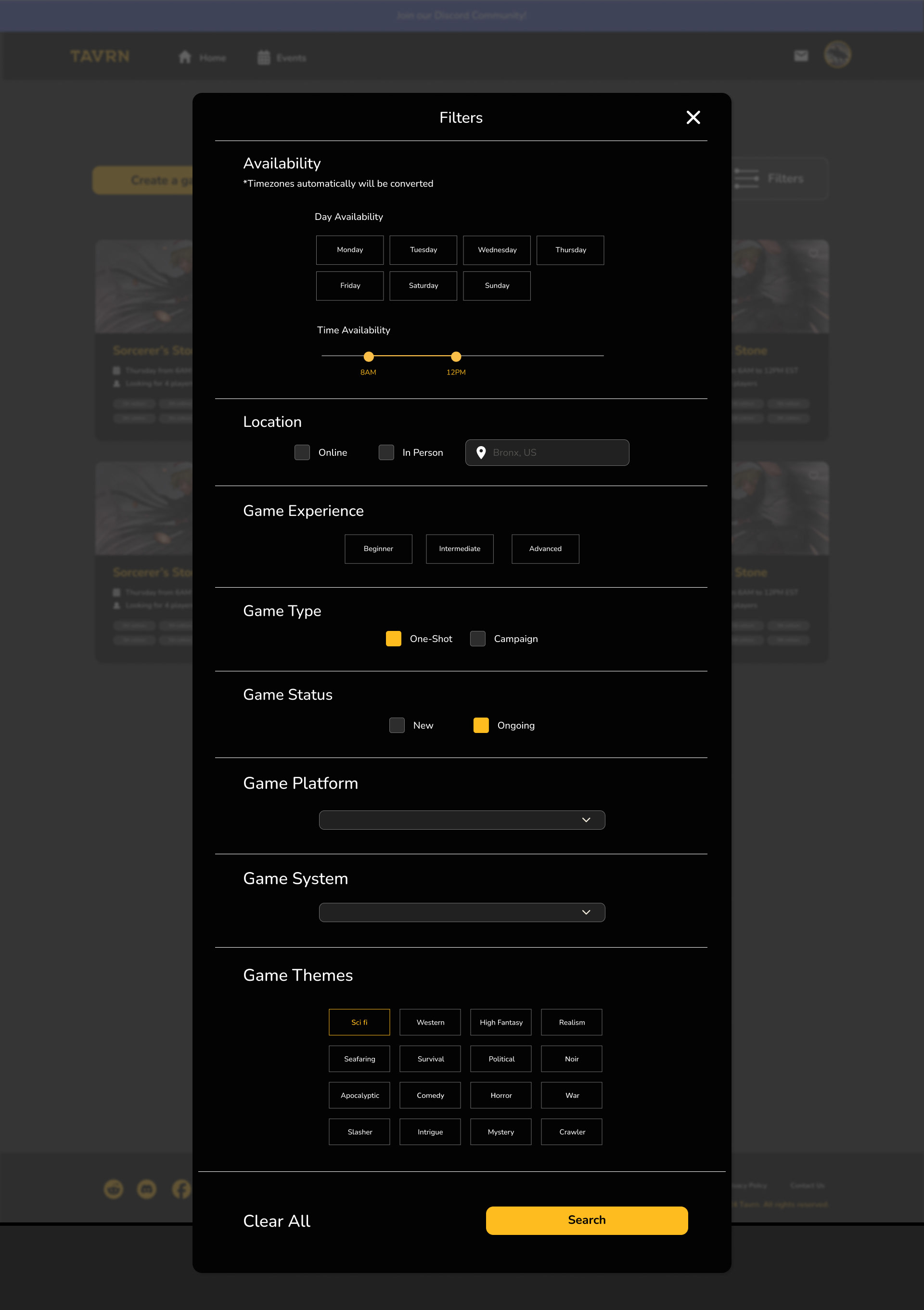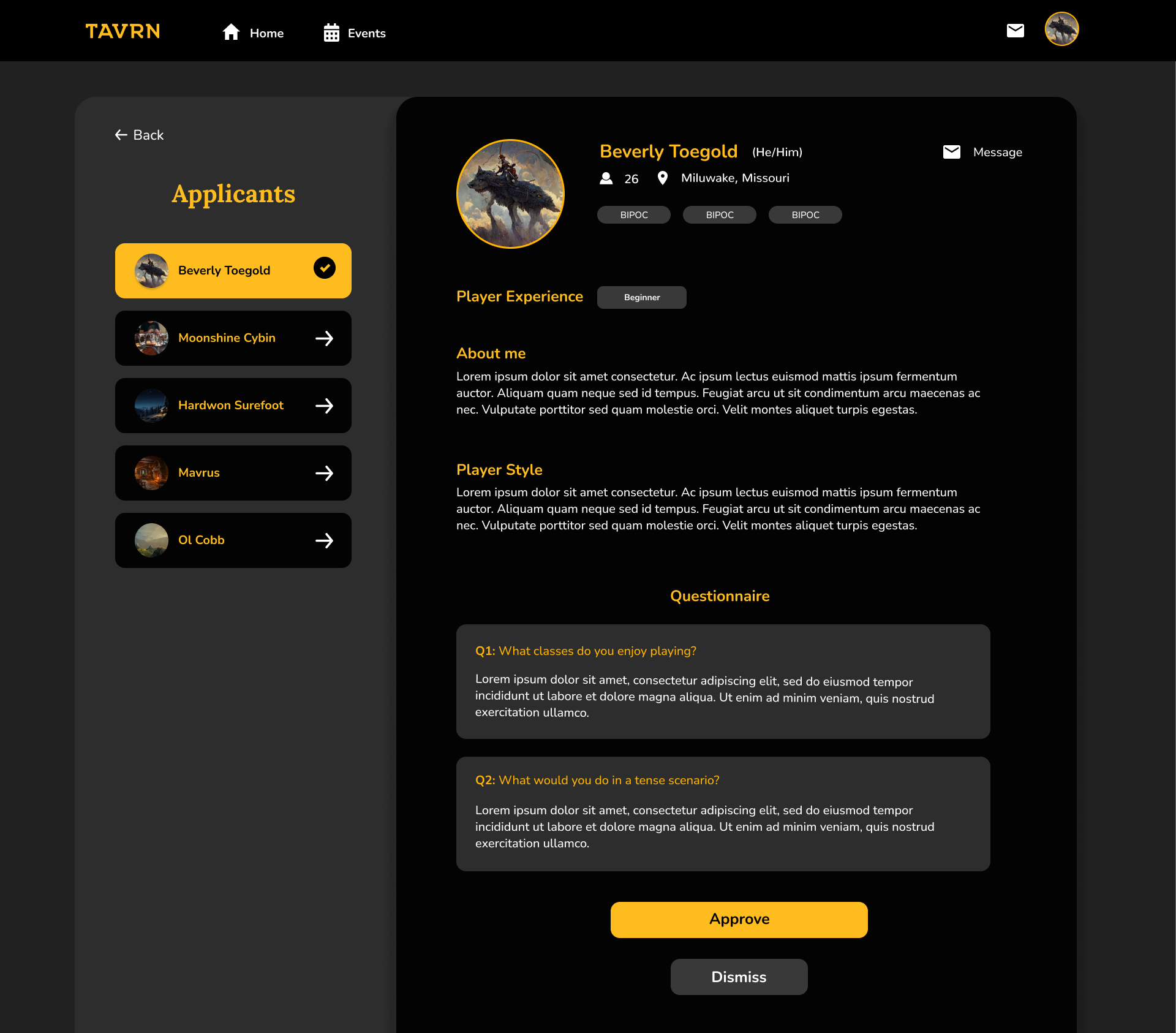Role: Founder, Product Designer
Timeline: 2023–Present
Team: 3 people (1 designer, 2 developers)
Responsibilities: Research, branding, UX strategy, UI design, community engagement, marketing
Tools: Figma, Adobe Illustrator, Adobe Photoshop
Timeline: 2023–Present
Team: 3 people (1 designer, 2 developers)
Responsibilities: Research, branding, UX strategy, UI design, community engagement, marketing
Tools: Figma, Adobe Illustrator, Adobe Photoshop
The Problem
As a Dungeons & Dragons player, I was excited to join a game—but frustrated by how difficult it was to find one.
I scrolled through Reddit’s /lfg, Discord servers, and Facebook groups only to find incomplete listings, slow replies, or dead threads. Even when I did find a game, I had to write a whole bio from scratch and apply via a Google Form, hoping someone would respond.
The tools for playing D&D were great. The tools for finding games? Not so much.
The Opportunity
There was no single, user-friendly platform built specifically for game discovery and group matching.
Players needed a way to easily search for games that matched their schedule and playstyle, a profile that acted like a “player resume,” and a sense of safety and transparency before joining a new group. Dungeon Masters, on the other hand, needed a faster way to post and manage game listings, a simple tool to review and approve applicants, and more time spent storytelling and less time organizing logistics.
My Role
I was the creator, researcher, and lead designer on the project. Working closely with a small development team, I helped bring Tavrn from an idea to a living product.
My responsibilities included conducting user research, developing the product strategy, designing the user experience and interface in Figma, establishing the brand identity, and leading the marketing efforts—from crafting launch copy to managing social content.
1. Research & Discovery
To build Tavrn, I began with extensive research into how people were currently finding tabletop games.
I explored Reddit threads, Discord communities, Facebook groups, and Google Forms used by DMs to recruit players. I interviewed both players and Dungeon Masters, looking for patterns and pain points. Across the board, users expressed frustration at how disjointed and informal the process felt.
Players were tired of reintroducing themselves every time they applied to a game, and DMs frequently felt overwhelmed by vague applications or no-shows. Safety tools like “Lines & Veils” and content expectations were rarely included, despite being valued by most players. Through this research, it became clear that what the community wanted was structure, clarity, and a centralized hub that respected their time and effort.
2. Designing for How People Actually Play
I wanted Tavrn to feel like a virtual tavern—cozy, warm, and familiar.
It needed to strike a balance between fantasy immersion and modern UX clarity. From color palette to layout, the experience was designed to echo the vibe of sitting in a candlelit inn, waiting for your party to assemble before an epic quest.
Functionally, Tavrn focused on streamlining three main flows: exploring games, applying to them, and managing those interactions. Players could build reusable profiles to avoid repeating the same “about me” blurb every time. Games could be filtered by time, theme, format, and experience level, making it easy to find a good match. Dungeon Masters had access to a dashboard where they could manage applications and see player profiles at a glance. Game listings also included safety tools, content tags, and detailed session info, promoting transparency and setting clear expectations from the start.
3. Building an MVP
The first version of Tavrn included an explore page where players could browse games using robust filters like timezone, game system, theme, and availability. Each player had a customizable profile that stored preferences, bios, and previous experience. Applying to a game became a one-click action that referenced your profile, cutting down the friction entirely.
For DMs, we built a dashboard to manage applicants, view player details, and approve or reject with ease. We also integrated features like timezone conversion, a simple events system, and a section for safety tools like X-cards, content warnings, and play expectations. To ensure accessibility and trust, the entire site was mobile-responsive and designed with a calm, fantasy-inspired interface using deep browns and gold accents that evoked the warmth of a tavern setting.
Roadblocks and Lessons Learned
1. DMs Were Dropping Off
Early on, we noticed a problem: DMs were posting games, but never returning to approve applicants.
It wasn’t a product problem—it was a habit problem. So I added scheduled email reminders and worked on creating feedback loops to reward return visits for a future update(like reviews and endorsements).
Lesson: Functionality is nothing without retention. Your product needs to bring people back intentionally.
2. Messaging System: An Afterthought
We launched without a messaging system—big mistake. Players had no way of messaging their DM if they'd been accepted and vice versa.
It was a turning point in the design process. We prioritized on building a messaging system, but in the meantime required game applicants and DM's to supply their Discord handles so that there was some means of communication between the two parties.
Lesson: Communication tools aren’t “extra.” They’re essential infrastructure.
3. Mobile friendly
We also learned that mobile users accounted for more than half of our visitors, prompting a reevaluation of the mobile UI and navigation.
Features like filters, application buttons, and profile editing needed to be just as seamless on a phone as they were on desktop. Thankfully the design components that were created for desktop were very easy to adjust to a mobile interface.
Lesson: Planning ahead for components to look seamless on both desktop and mobile will save time in the future.
Community Partnerships
A major growth milestone was our partnership with Crit or Quit, a well-known tabletop Discord community.
We built an integration that allowed games created on Tavrn by Crit or Quit DMs to automatically post into their server. This reduced friction, extended game visibility, and helped drive user signups directly from the community.
By bridging the gap between Tavrn and communities like Crit or Quit, we made it easier for games to be discovered and players to apply with confidence. Dungeon Masters saved time formatting listings, and players felt more comfortable knowing the games came from a vetted, trusted group.
Outcome
Within the first four months of launch, over 600 users joined Tavrn. Dozens of games were posted, applied to, and played. The platform began generating its own word-of-mouth growth as more users realized how much easier it was to find compatible games without the usual forum clutter. Our Discord integration and event listings helped us stay connected to the community and informed our next updates, which were guided by direct user feedback and feature requests.
What’s Next
Tavrn is actively evolving.
We’re currently working on a messaging system for direct communication between players and DMs, a player/DM endorsement and rating system, and deeper integrations like D&D Beyond character syncing.
Final Thoughts
Tavrn was born from a simple question: Why is finding a game harder than playing one?
It’s been incredibly rewarding to build something that makes tabletop gaming more accessible, social, and fun—and there’s so much more to come.

Explore Games

Filter Games

Application Review

Game Details

Event Explore

Event Details
